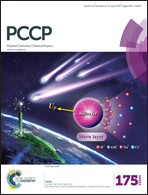The effect of hydrogen bonding propensity and enantiomeric composition on the dynamics of supercooled ketoprofen – dielectric, rheological and NMR studies†
Abstract
The aim of this work is to analyze in detail the effect of small hydrogen bonding (HB) structures and enantiomeric composition on the dynamics of glass-forming liquid ketoprofen. For that purpose dielectric relaxation, rheological and NMR studies were performed. Investigated samples are racemic ketoprofen, a single enantiomer of ketoprofen and a racemic ketoprofen methyl ester with no tendency to form HB dimers. The combination of complementary experimental techniques enables us to show that macroscopic viscosity η and α-relaxation time τα have nearly the same temperature dependencies, whereas the relation between the viscosity (or molecular reorientation) and the translational self-diffusion coefficient violates Stokes–Einstein law already at high temperature. Additionally, based on dielectric relaxation studies performed on increased pressure we were able to identify similarities and key differences in the supercooled liquid dynamics of investigated materials affected by their tendency to form intermolecular hydrogen bonds. This includes the effect of pressure on the glass transition temperature Tg, changes in the fragility parameter m and activation volume ΔV, the role of thermal energy and density fluctuations in governing the viscous liquid dynamics (Ev/Ep ratio). Finally, we have also demonstrated that the dynamic behaviour of a single enantiomer and the racemic mixture of the same compound are very much alike. Nevertheless, some slight differences were observed, particularly in the τα(T) dependencies measured in the vicinity of glass transition both at ambient and elevated pressure.


 Please wait while we load your content...
Please wait while we load your content...